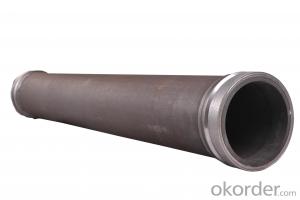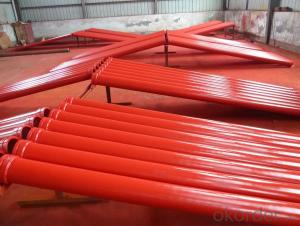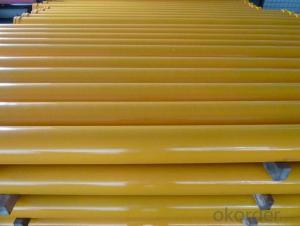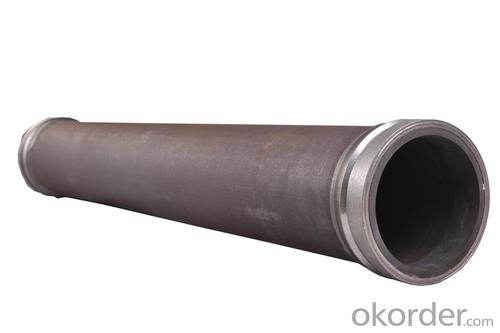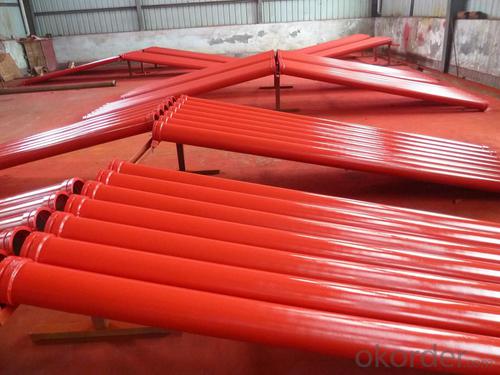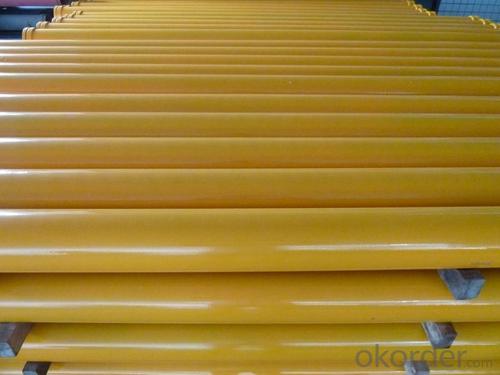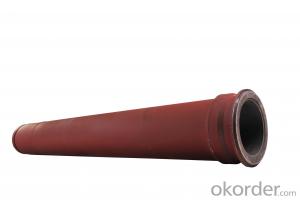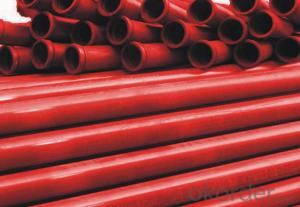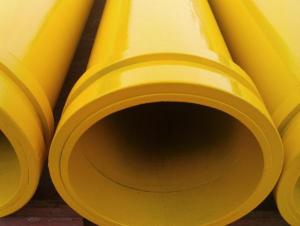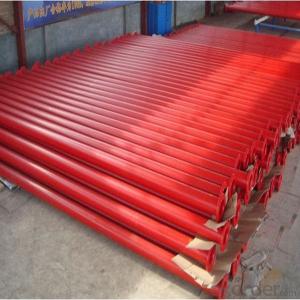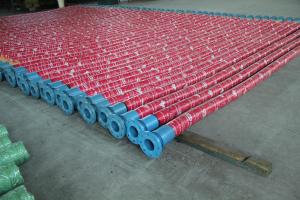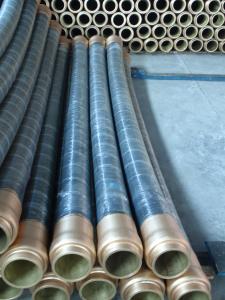Twin Wall Pipe for Concrete Pump Pipe Thickness 7mm Length 3000mm
- Loading Port:
- Tianjin
- Payment Terms:
- TT or LC
- Min Order Qty:
- 50 pc
- Supply Capability:
- 2000 pc/month
OKorder Service Pledge
OKorder Financial Service
You Might Also Like
Product Description:
Product Name: Twin Wall Pipe for Concrete Pump Pipe Thickness 7mm Length 3000mm
Specification
Diameter: DN125
Wall thickness: inner wall is 4 mm 65Mn, outer wall is 3mm seamless steel
Length: 3000&2000&1000mm with wear resistant SK flange
Type: Double / twin wall
Hardness: HRC 63
Using life: 60,000-100,000(CBM)
Highlights: longest using life
Welding: Smooth welding between straight pipes and flanges
Color : as customer's requirement,usually bule or red
Surface: Electrostatic Spraying Epoxy Paint
3. Application
Concrete delivery.
4. Package
Put into containers.
FAQ:
Q1: Why buy Materials & Equipment from OKorder.com?
A1: All products have its ISO certifications, adheres to the highest standards and a commitment to supply chain safety and customer satisfaction.
Q2: How do we guarantee the quality of our products?
A2: We have established an advanced quality management system which conducts strict quality tests at every step, from raw materials to the final product. At the same time, we provide extensive follow-up service assurances as required.
Q3: How soon can we receive the product after purchase?
A3: Within three days of placing an order, we will begin production. The specific shipping date is dependent upon international and government factors, but is typically 10 to 30 workdays.
Q4: If we can produce Twin Wall Pipe for Concrete Pump Pipe according to customers request?
A4: Yes, we can produce Twin Wall Pipe for Concrete Pump Pipe according to the difference country situations to make it suitable to the market and customers. We have very professional technical team to make the design.
Q5: How to make a quick resolution for after service?
A5: We have overseas branches all-around of world, If needed, the seller shall dispatch 2 engineers to the buyer's site for supervision of training. The buyer shall make available of necessary facilities &skilled personnel at site for training.
Images:
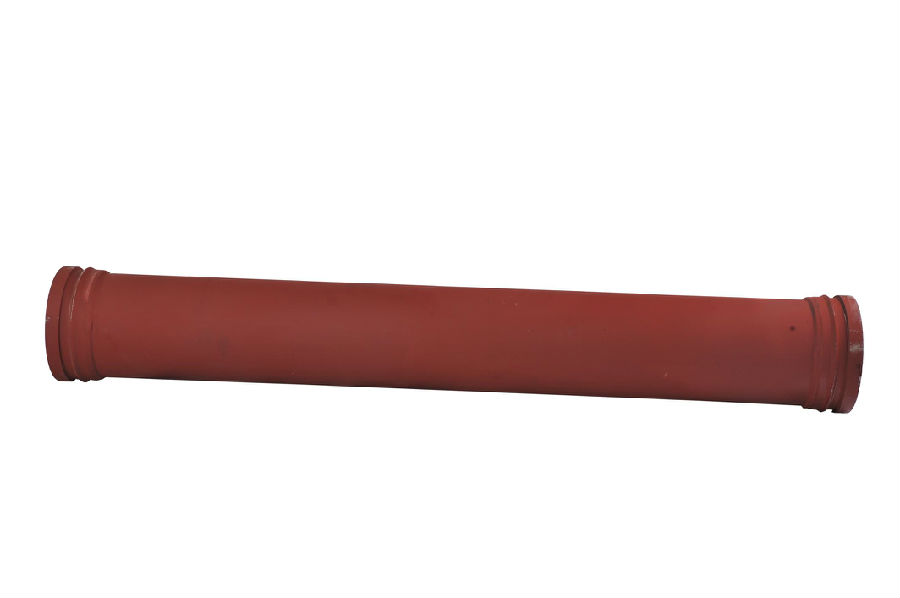
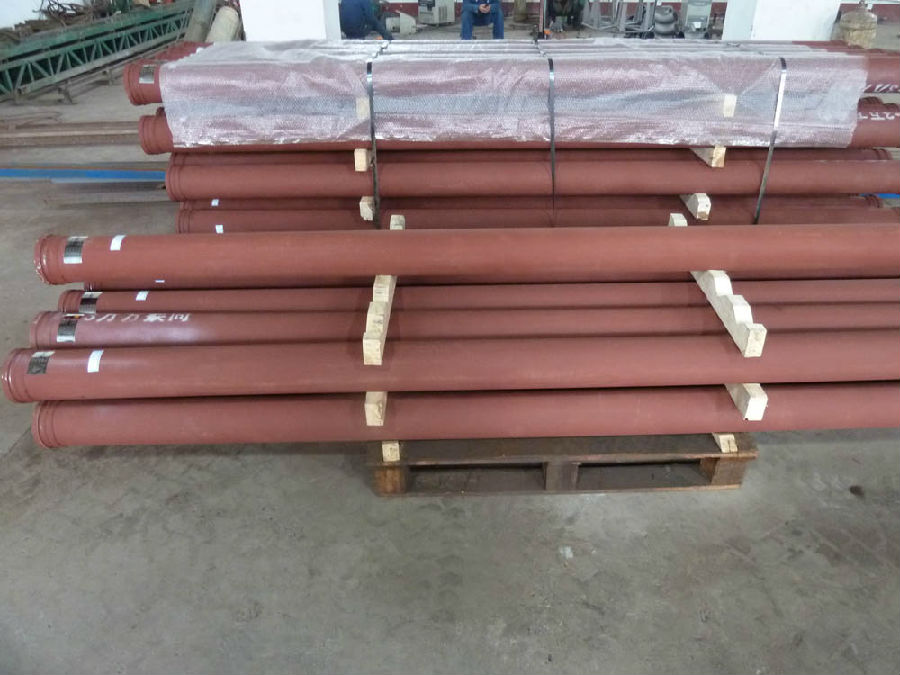
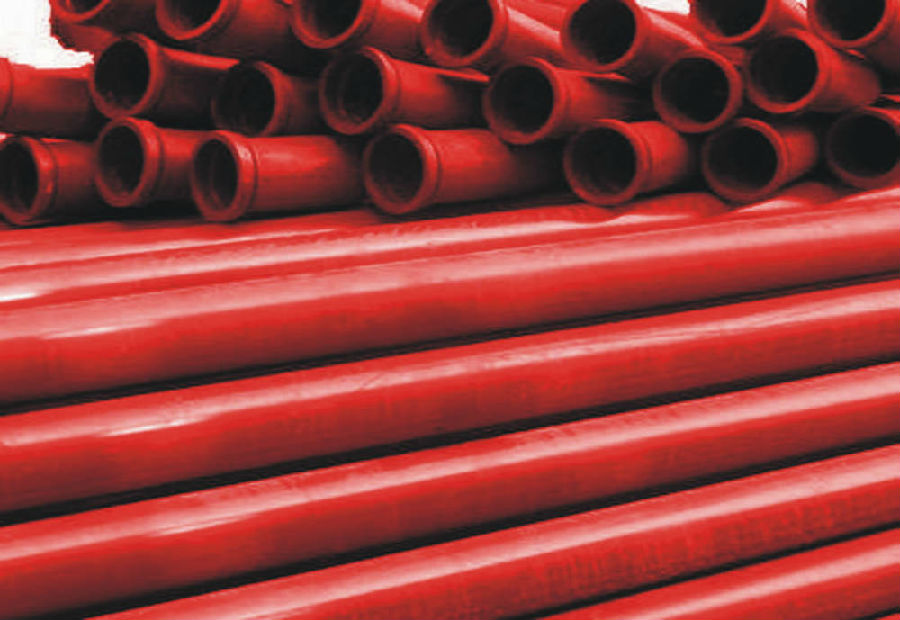
- Q: Can concrete pump spare parts be pre-assembled or pre-tested before installation?
- Yes, concrete pump spare parts can be pre-assembled or pre-tested before installation. Pre-assembling the spare parts allows for quality control measures to be taken before the actual installation process. This ensures that any defects or issues with the parts can be identified and rectified before they are installed in the concrete pump. Additionally, pre-testing the spare parts helps to ensure their functionality and compatibility with the pump system. It allows for any necessary adjustments or modifications to be made beforehand, reducing the risk of complications during the actual installation process. Overall, pre-assembling and pre-testing concrete pump spare parts is a common practice to ensure the smooth and efficient operation of the pump system.
- Q: What is the purpose of a concrete pump agitator motor?
- The purpose of a concrete pump agitator motor is to mix and agitate the concrete mixture inside the pump, ensuring a consistent and homogenous blend. This helps to prevent the concrete from settling or segregating, ensuring a higher quality and more workable mixture for construction purposes.
- Q: What is the purpose of a concrete pump hydraulic accumulator bladder?
- The purpose of a concrete pump hydraulic accumulator bladder is to store and release hydraulic energy within a concrete pump system. The bladder acts as a flexible barrier between the hydraulic fluid and a gas or air chamber. When hydraulic fluid is pumped into the bladder, it compresses the gas or air inside, storing potential energy. This energy can then be released when needed to power the hydraulic system, providing a surge of pressure and flow to ensure efficient and controlled movement of the concrete. The hydraulic accumulator bladder serves several important functions in a concrete pump system. Firstly, it helps to smooth out and regulate the flow of hydraulic fluid, reducing pressure fluctuations and ensuring a steady and consistent supply of power to the pump. This helps to prevent damage to the pump components and ensures a more reliable and efficient operation. Additionally, the bladder helps to compensate for variations in demand. As the concrete pump operates, there may be times when the demand for hydraulic power exceeds the supply. In such cases, the bladder can release the stored energy to meet the increased demand, providing a temporary boost to the hydraulic system. This helps to maintain a consistent and continuous flow of concrete, even during peak demand periods. Furthermore, the hydraulic accumulator bladder can also act as a safety device. In the event of a sudden pressure surge or spike in the hydraulic system, the bladder can absorb and dampen the excess pressure, preventing damage to the pump or other components. This helps to protect the equipment and ensure the safety of the operators. In summary, the purpose of a concrete pump hydraulic accumulator bladder is to store and release hydraulic energy, smooth out and regulate hydraulic fluid flow, compensate for variations in demand, and act as a safety device. By performing these functions, the bladder helps to optimize the performance and efficiency of the concrete pump system, ensuring a reliable and controlled movement of concrete.
- Q: Can I get spare parts for both concrete pumps with and without boom control systems?
- Spare parts for both concrete pumps, with or without boom control systems, are generally available. Numerous manufacturers and suppliers offer a diverse selection of spare parts to cater to various pump types. Whether your pump has a boom control system or not, reliable suppliers should have the necessary spare parts in stock. To ensure compatibility and check availability for your specific concrete pump model, it is advisable to directly contact the manufacturer or supplier.
- Q: How can one determine the correct pressure and flow rating for hydraulic components in concrete pump spare parts?
- To determine the correct pressure and flow rating for hydraulic components in concrete pump spare parts, several factors need to be considered: 1. Manufacturer's specifications: Review the manufacturer's specifications for the hydraulic components. The specifications should include the recommended pressure and flow ratings for optimum performance and durability. 2. System requirements: Assess the specific requirements of the concrete pump system. Consider factors such as the size of the pump, the volume and distance of concrete being pumped, and the speed at which the concrete needs to be delivered. These factors will help determine the required pressure and flow rating for the hydraulic components. 3. Safety considerations: Ensure that the pressure and flow rating of the hydraulic components are within the safe operating limits of the concrete pump system. Exceeding these limits can lead to equipment failure, accidents, or damage to the components. 4. Compatibility: Verify that the hydraulic components are compatible with the rest of the system. The pressure and flow rating should match the capabilities and specifications of other components such as the pump, valves, and hoses to ensure proper functionality and performance. 5. Consultation with experts: If unsure about the appropriate pressure and flow rating for hydraulic components, consult with hydraulic system experts or the manufacturer's technical support team. They can provide guidance based on their expertise and experience with similar systems. It is important to note that the pressure and flow rating of hydraulic components may vary depending on the specific model, design, and intended application. Therefore, it is crucial to refer to the manufacturer's guidelines and recommendations to ensure accurate determination of the correct pressure and flow rating for hydraulic components in concrete pump spare parts.
- Q: What are some common issues with concrete pump pipes and how can they be prevented?
- Concrete pump pipes can experience several common issues, including blockages, leaks, and wear and tear. These problems can be avoided by implementing appropriate maintenance and operational practices. 1. Blockages: Concrete hardening inside the pipe can obstruct the flow, resulting in blockages. Regularly cleaning the pipes after each use is crucial to prevent blockages. Flushing the pipes with water or using a high-pressure air hose can eliminate any remaining material and prevent buildup. Furthermore, using concrete mixtures with the correct consistency and avoiding excessive use of additives can minimize the chances of blockages. 2. Leaks: Cracks or gaps in the pipe can cause concrete to leak out. Regularly inspecting the pipes is vital to detect any signs of damage or wear. Promptly repairing or replacing damaged sections can prevent leaks. It is also essential to use high-quality pipes that resist abrasion and chemical corrosion as they are less likely to develop leaks. 3. Wear and Tear: The operation of concrete pump pipes exposes them to significant stress and abrasion. This can eventually lead to wear and tear, resulting in weakened pipes or even breakages. To prevent excessive wear, it is important to utilize pipes made from durable materials like hardened steel or composite materials. Regularly inspecting the pipes for signs of wear, such as thinning or deformation, and replacing them as needed can help prevent sudden failures. 4. Pipe movement and alignment issues: During operation, concrete pump pipes may shift or become misaligned, which can decrease efficiency and potentially cause damage. To prevent this, ensure that the pipes are securely fastened to the pump and properly aligned. Using clamps and brackets or employing anti-vibration measures can help maintain the stability and alignment of the pipes during pumping operations. 5. Operator errors: Improper handling and operation can also contribute to problems with concrete pump pipes. Operators should receive adequate training in pump operation and pipe handling. Following recommended operating procedures, avoiding excessive pressure or flow rates, and exercising caution while maneuvering the pipes can prevent unnecessary strain and damage. In conclusion, proactive maintenance, proper handling, and the use of high-quality pipes can greatly reduce common issues with concrete pump pipes, ensuring smooth and efficient concrete pumping operations.
- Q: How does a hopper agitator blade ensure smooth concrete flow?
- To guarantee a seamless flow of concrete, a hopper agitator blade is employed to mix and disintegrate any clumps or air pockets in the concrete mixture. Specifically designed to be positioned inside the hopper, the blade rotates and agitates the concrete, ensuring a homogeneous and steady state. While in rotation, the blade disperses any settled aggregates at the hopper's base, preventing blockages or uneven distribution during the pouring procedure. This uninterrupted mixing action guarantees that the concrete remains well-blended and effortlessly pours out of the hopper. Furthermore, the agitator blade aids in breaking up any air bubbles that may have formed within the concrete mixture. These air bubbles can compromise the structural integrity of the concrete and lead to an uneven final appearance. By agitating the concrete, the blade effectively releases trapped air, promoting a consistently dense mixture. In essence, a hopper agitator blade guarantees a seamless flow of concrete by effectively blending the mixture, breaking apart any clumps or air pockets, and fostering a uniform composition. This ensures that the concrete pours smoothly and evenly during the pouring process, resulting in a top-notch end product.
- Q: What do these types of concrete pumps mean?
- Concrete conveying pump HBT80-18-16: according to the national standard "GB/T13333-2004_ concrete pump"
- Q: What are the types of concrete pumps?
- According to the power type is divided into electric concrete pump and diesel power concrete pump
- Q: Can I reuse old concrete pump spare parts?
- Reusing old concrete pump spare parts is a possibility, depending on their condition. In the event that the spare parts are in good working order and successfully pass the required inspections, they can be reused to cut costs and minimize waste. Nevertheless, it is crucial to verify that the recycled spare parts are suitable for the specific model and type of concrete pump in use. Seeking advice from a professional or the manufacturer is advised in order to ascertain the safety of reusing the old spare parts.
Send your message to us
Twin Wall Pipe for Concrete Pump Pipe Thickness 7mm Length 3000mm
- Loading Port:
- Tianjin
- Payment Terms:
- TT or LC
- Min Order Qty:
- 50 pc
- Supply Capability:
- 2000 pc/month
OKorder Service Pledge
OKorder Financial Service
Similar products
Hot products
Hot Searches
Related keywords
